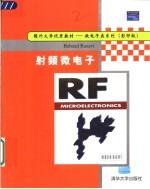图书介绍
射频微电子pdf电子书版本下载

- (美)拉扎维(Razawi,B.)著 著
- 出版社: 北京:清华大学出版社
- ISBN:7302075220
- 出版时间:2003
- 标注页数:335页
- 文件大小:15MB
- 文件页数:349页
- 主题词:射频-微电子技术-高等学校-教材-英文
PDF下载
下载说明
射频微电子PDF格式电子书版下载
下载的文件为RAR压缩包。需要使用解压软件进行解压得到PDF格式图书。建议使用BT下载工具Free Download Manager进行下载,简称FDM(免费,没有广告,支持多平台)。本站资源全部打包为BT种子。所以需要使用专业的BT下载软件进行下载。如 BitComet qBittorrent uTorrent等BT下载工具。迅雷目前由于本站不是热门资源。不推荐使用!后期资源热门了。安装了迅雷也可以迅雷进行下载!
(文件页数 要大于 标注页数,上中下等多册电子书除外)
注意:本站所有压缩包均有解压码: 点击下载压缩包解压工具
图书目录
1 Introduction to RF and Wireless Technology 1
1.1 Complexity Comparison 2
1.2 Design Bottleneck 4
1.3 Applications 6
1.4 Analog and Digital Systems 7
1.5 Choice of Technology 9
References 10
2 Basic Concepts in RF Design 11
2.1 Nonlinearity and Time Variance 11
2.1.1 Effects of Nonlinearity 14
2.1.2 Cascaded Nonlinear Stages 22
2.2 Intersymbol Interference 25
2.3 Random Processes and Noise 28
2.3.1 Random Processes 29
2.3.2 Noise 37
2.4 Sensitivity and Dynamic Range 48
2.5 Passive Impedance Transformation 50
References 53
3 Modulation and Detection 54
3.1 General Considerations 54
3.2 Analog Modulation 57
3.2.1 Amplitude Modulation 57
3.2.2 Phase and Frequency Modulation 58
3.3 Digital Modulation 63
3.3.1 Basic Concepts 64
3.3.2 Binary Modulation 74
3.3.3 Quadrature Modulation 81
3.4 Power Efficiency of Modulation Schemes 90
3.4.1 Constant-and Variable-Envelope Signals 90
3.4.2 Spectral Regrowth 91
3.5 Noncoherent Detection 93
References 96
4.1 Mobile RF Communications 98
4 Multiple Access Techniques and Wireless Standards 98
4.2 Multiple Access Techniques 103
4.2.1 Time-and Frequency-Division Duplexing 103
4.2.2 Frequency-Division Multiple Access 105
4.2.3 Time-Division Multiple Access 105
4.2.4 Code-Division Multiple Access 107
4.3 Wireless Standards 110
4.3.1 Advanced Mobile Phone Service 111
4.3.2 North American Digital Standard 112
4.3.3 Global System for Mobile Communication 113
4.3.4 Qualcomm CDMA 114
4.3.5 Digital European Cordless Telephone 116
References 117
5 Transceiver Architectures 118
5.1 General Considerations 118
5.2.1 Heterodyne Receivers 122
5.2 Receiver Architectures 122
5.2.2 Homodyne Receivers 129
5.2.3 Image-Reject Receivers 138
5.2.4 Digital-IF Receivers 146
5.2.5 Subsampling Receivers 147
5.3 Transmitter Architectures 149
5.3.1 Direct-Conversion Transmitters 152
5.3.2 Two-Step Transmitters 154
5.4 Transceiver Performance Tests 155
5.5 Case Studies 157
5.5.1 Motorola's FM Receiver 157
5.5.2 Philips'Pager Receiver 158
5.5.3 Philips'DECT Transceiver 159
5.5.4 Lucent Technologies'GSM Transceiver 161
5.5.5 Philips'GSM Transceiver 162
References 163
6.1 Low-Noise Amplifiers 166
6.1.1 General Considerations 166
6 Low-Noise Amplifiers and Mixers 166
6.1.2 Input Matching 170
6.1.3 Bipolar LNAs 173
6.1.4 CMOS LNAs 178
6.2 Downconversion Mixers 180
6.2.1 General Considerations 180
6.2.2 Bipolar Mixers 188
6.2.3 CMOS Mixers 192
6.2.4 Noise in Mixers 194
6.3 Cascaded Stages Revisited 200
References 204
7 Oscillators 206
7.1 General Considerations 206
7.2 Basic LC Oscillator Topologies 209
7.3 Voltage-Controlled Oscillators 212
7.4 Phase Noise 214
7.4.1 Effect of Phase Noise in RF Communications 215
7.4.2 Q of an Oscillator 217
7.4.3 Phase Noise Mechanisms 220
7.4.4 Noise-Power Trade-off 224
7.4.5 Effect of Frequency Division and Multiplication on Phase Noise 224
7.4.6 Oscillator Pulling and Pushing 225
7.5 Bipolar and CMOS LC Oscillators 227
7.5.1 Negative-Gm Oscillators 227
7.5.2 Interpolative Oscillators 231
7.6 Monolithic Inductors 233
7.7 Resonatorless VCOs 235
7.8 Quadrature Signal Generation 236
7.8.1 RC-CR Network 236
7.8.2 Havens'Technique 239
7.8.3 Frequency Division 243
7.9 Single-Sideband Generation 243
References 244
8.1 General Considerations 247
8 Frequency Synthesizers 247
8.2 Phase-Locked Loops 249
8.2.1 Basic Concepts 249
8.2.2 Basic PLL 252
8.2.3 Charge-Pump PLLs 258
8.2.4 Type Ⅰ and Type Ⅱ PLLs 265
8.2.5 Noise in PLLs 266
8.2.6 Phase Noise at Input 266
8.2.7 Phase Noise of VCO 267
8.2.8 Frequency Multiplication 269
8.3 RF Synthesizer Architectures 269
8.3.1 Integer-N Architecture 270
8.3.2 Fractional-N Architecture 277
8.3.3 Dual-Loop Architectures 284
8.3.4 Direct Digital Synthesis 285
8.4 Frequency Dividers 290
8.4.1 Divide-by-Two Circuits 290
8.4.2 Dual-Modulus Dividers 293
References 296
9 Power Amplifiers 298
9.1 General Considerations 298
9.1.1 Linear and Nonlinear PAs 301
9.2 Classification of Power Amplifiers 301
9.2.1 Class A and B PAs 302
9.2.2 Class C PAs 305
9.3 High-Efficiency Power Amplifiers 306
9.4 Large-Signal Impedance Matching 310
9.5 Linearization Techniques 313
9.5.1 Feedforward 314
9.5.2 Feedback 315
9.5.3 Envelope Elimination and Restoration 317
9.5.4 LINC 318
9.6 Design Examples 320
References 323